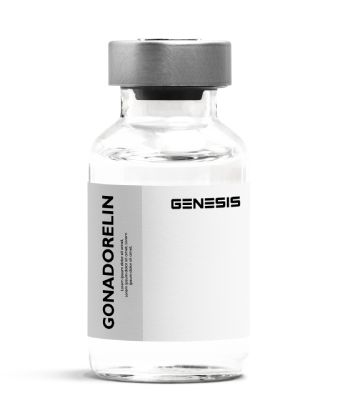Semaglutide injection is used to treat type 2 diabetes. It is used together with diet and exercise to help control your blood sugar. This medicine is also used to lower the risk of heart attack, stroke, or death in patients with type 2 diabetes and heart or blood vessel disease.
$59.50
Gonadorelin, also known as gonadotropin-releasing hormone (GnRH), is a naturally occurring peptide hormone produced in the hypothalamus of the brain. It plays a crucial role in the regulation of the reproductive system by stimulating the release of luteinizing hormone (LH) and follicle-stimulating hormone (FSH) from the pituitary gland.
Gonadorelin acts on specific receptors in the anterior pituitary gland, promoting the synthesis and secretion of LH and FSH. These hormones, in turn, stimulate the production of testosterone in males and the growth and maturation of ovarian follicles in females, supporting ovulation and the menstrual cycle.
Due to its role in regulating reproductive function, gonadorelin has various medical applications. It is used in diagnostic tests to assess pituitary and gonadal function, as well as in the treatment of certain infertility disorders. Additionally, gonadorelin analogs or synthetic versions are utilized in assisted reproductive technologies such as in vitro fertilization (IVF) to control ovulation and improve fertility outcomes.
It’s important to note that gonadorelin is available in different forms for medical use, including injectable formulations and nasal sprays. However, its administration and usage should always be under the guidance and supervision of a healthcare professional.
Gonadorelin, also known as gonadotropin-releasing hormone (GnRH), plays a crucial role in regulating the reproductive system. It works by stimulating the release of two key hormones: luteinizing hormone (LH) and follicle-stimulating hormone (FSH). These hormones are produced and released by the pituitary gland in response to the action of gonadorelin.
Hypothalamus Activation: Gonadorelin is produced in the hypothalamus, a region of the brain responsible for controlling hormone secretion. In response to various physiological signals, the hypothalamus releases gonadorelin into the bloodstream.
Pituitary Gland Stimulation: Once in the bloodstream, gonadorelin reaches the pituitary gland, a small gland located at the base of the brain. It binds to specific receptors on the cells of the pituitary gland.
LH and FSH Release: Binding of gonadorelin to the pituitary receptors triggers the release of LH and FSH into the bloodstream. These hormones are essential for the functioning of the reproductive system in both males and females.
Luteinizing Hormone (LH): LH is a hormone secreted by the anterior pituitary gland that stimulates ovulation in females and stimulates the production of testosterone in males. In males, LH stimulates the Leydig cells in the testes to produce testosterone, which is important for sperm production and sexual development. In females, LH stimulates the production of estrogen and progesterone, which regulate the menstrual cycle and support the development of ovarian follicles.
Follicle-Stimulating Hormone (FSH): FSH plays a crucial role in the growth and maturation of ovarian follicles in females and the production of sperm in males. In females, FSH stimulates the growth of ovarian follicles, which contain the eggs. It also promotes the production of estrogen by the follicles. In males, FSH stimulates the Sertoli cells in the testes, which support sperm development and maturation.
Feedback Regulation: The release of LH and FSH triggers a cascade of hormonal events that eventually regulate the levels of gonadorelin. The hormones released in response to gonadorelin, such as testosterone and estrogen, provide feedback to the hypothalamus and pituitary gland, regulating the further release of gonadorelin and maintaining a delicate balance in the reproductive system.
By stimulating the release of LH and FSH, gonadorelin helps regulate the menstrual cycle in females, support ovulation, and promote sperm production and sexual development in males. Its precise control over these reproductive hormones makes it a valuable tool in diagnosing and treating various reproductive disorders.
IMG
Gonadorelin, also known as gonadotropin-releasing hormone (GnRH), plays a crucial role in regulating the reproductive system by stimulating the release of LH and follicle-stimulating hormone (FSH). These hormones are vital for the production of testosterone in males. The interaction between gonadorelin and testosterone is essential for maintaining male reproductive health and function.
Gonadorelin acts on the pituitary gland, triggering the release of LH, which in turn stimulates the Leydig cells in the testes to produce testosterone. Testosterone is a primary male sex hormone responsible for the development and maintenance of male sexual characteristics, fertility, and overall well-being potential health.
Testosterone plays a crucial role in male reproductive function. It is necessary for the development and maturation of sperm cells, as well as the regulation of sexual desire and performance. Testosterone also influences muscle mass, bone density, mood, and energy levels in males.
Gonadorelin and testosterone have clinical applications in various conditions related to male reproductive health. They are commonly used in the diagnosis and treatment of hypogonadism, a condition characterized by low testosterone levels. Gonadorelin stimulation tests can help assess the functionality of the hypothalamic-pituitary-gonadal axis and identify the underlying causes of testosterone deficiency.
Gonadorelin, also known as gonadotropin-releasing hormone (GnRH), is a peptide hormone that plays a crucial role in regulating the reproductive system. It is a natural hormone produced in the hypothalamus of the brain and acts on the pituitary gland to stimulate the release of LH and FSH. Gonadorelin peptide has several important applications in the field of reproductive medicine and endocrinology.
Gonadorelin peptide acts as a potent stimulator of LH and FSH release from the anterior pituitary gland. The pulsatile release of GnRH is essential for maintaining the normal functioning of the reproductive system in both males and females. In males, LH stimulates the Leydig cells in the testes to produce testosterone, while FSH promotes sperm production in the testes. In females, LH triggers ovulation and the production of progesterone, while FSH stimulates follicle development and estrogen production.
Gonadorelin peptide is used in clinical settings to assess the functionality of the hypothalamic-pituitary-gonadal axis in male patients. Gonadotropin-releasing hormone stimulation tests are performed on male patients to evaluate the ability of the hypothalamus and pituitary glands to gland to respond to GnRH and release LH and FSH. These tests can help diagnose disorders such as hypogonadism, delayed puberty, and infertility.
Gonadorelin peptide is utilized in assisted reproductive techniques such as in vitro fertilization (IVF) and controlled ovarian stimulation (COS). In IVF, exogenous gonadorelin is administered to trigger the release of LH, which induces ovulation, enabling the retrieval of mature eggs for fertilization. In COS, gonadorelin is used in combination with other hormonal medications to promote the development and maturation of multiple follicles in the ovaries.
Gonadorelin peptide analogs, known as gonadotropin-releasing hormone agonists and antagonists, are used in the management of various reproductive disorders. These include conditions such as precocious puberty, endometriosis, uterine fibroids, and certain types of hormone-dependent cancers. By modulating the release of LH and FSH, these analogs can help regulate hormone levels and control the growth of hormone-sensitive tumors.
Testicular atrophy is a condition characterized by a decrease in testicular size and impaired testicular function. It can result from various causes, including hormonal imbalances, chronic diseases, and certain medications. Gonadorelin, a peptide hormone that stimulates the release of LH and FSH, holds promise as a therapeutic option for treating testicular atrophy. This article explores the potential benefits of gonadorelin in optimizing testicular size and function and restoring testicular health.
Gonadorelin acts directly on the pituitary gland to promote the release of LH and FSH, which play vital roles in testicular function. LH stimulates the Leydig cells in the testes to produce testosterone, the primary male sex hormone. FSH supports spermatogenesis, the process of sperm cell production. By enhancing the secretion of LH and FSH, gonadorelin helps restore optimal hormonal levels, thereby counteracting testicular atrophy.
Reversal of Hypogonadism:
Hypogonadism is a testosterone deficiency, a condition characterized by low testosterone levels, often leading to testicular atrophy. Gonadorelin is testosterone therapy that can address hypogonadism by the testosterone deficiency by stimulating the pituitary gland to release LH, which, in turn, triggers testosterone synthesis in the testes. By restoring testosterone levels, gonadorelin helps reverse testicular atrophy and improves the overall function of the pituitary glands and testes.
Augmentation of Sperm Production:
In cases where testicular atrophy is accompanied by impaired spermatogenesis, gonadorelin can be beneficial. By promoting the release of FSH, gonadorelin stimulates the growth and maturation of sperm cells in the seminiferous tubules of the testes. This augmentation of sperm production aids in improving fertility outcomes and can potentially help individuals with testicular atrophy to achieve parenthood.
Potential Non-Hormonal Effects:
Recent studies have suggested that gonadorelin may exert non-hormonal effects directly on testicular tissue. These effects include antioxidant and anti-inflammatory actions, which can protect testicular cells from oxidative stress and inflammation, both of which contribute to testicular atrophy. Further research is necessary to fully elucidate these mechanisms and their therapeutic implications.

Male fertility relies on the proper functioning of the reproductive system, including the production of testosterone, the primary male sex hormone. When testosterone levels are low, it can negatively impact fertility. Gonadorelin, a peptide hormone that stimulates the release of LH a hormone secreted by the anterior pituitary gland that stimulates ovulation in females and holds potential in improving some male patients’ fertility by enhancing testosterone synthesis. This article explores the role of gonadorelin in optimizing fertility and its potential as a therapeutic option for men experiencing fertility challenges.
Stimulation of Testosterone Production:
Gonadorelin acts on the pituitary gland, stimulating the release of LH. LH then acts on the Leydig cells in the testes, triggering the synthesis and secretion of testosterone. By increasing LH levels, gonadorelin promotes testosterone synthesis, which is crucial for sperm development, maturation, and overall reproductive function.
Restoration of Hormonal Imbalance:
Imbalances in the hormonal system can contribute to male infertility. Gonadorelin, testosterone therapy that can help restore hormonal balance by targeting the hypothalamic-pituitary-gonadal axis. By enhancing LH release, gonadorelin treatment helps normalize testosterone levels, which are vital for the proper functioning of the male reproductive system.
Improvement in Sperm Quality and Quantity:
Testosterone plays a critical role in spermatogenesis, the process of sperm cell production. Low testosterone levels can lead to decreased sperm quality and quantity, negatively impacting fertility. By stimulating testosterone making, gonadorelin promotes the development of healthy sperm cells, improving sperm motility, morphology, and overall fertility potential.
Potential Combination Therapy:
Gonadorelin can be used in combination with other hormones in fertility treatments to optimize outcomes. For example, in assisted reproductive techniques such as in vitro fertilization (IVF) or intracytoplasmic sperm injection (ICSI), gonadorelin can be administered to enhance testosterone levels and improve the quality of retrieved sperm, increasing the chances of successful fertilization.

A fulfilling and satisfying sexual experience is an integral part of overall well-being and quality of life. For individuals experiencing a decline in sexual desire or libido, Gonadorelin, a peptide hormone known for its role in reproductive function, shows promise in revitalizing and enhancing sexual desire. This article delves into the potential of Gonadorelin in increasing libido and reigniting the spark in intimate relationships.
Influence on the Hypothalamic-Pituitary-Gonadal Axis:
Gonadorelin plays a crucial role in regulating the release of gonadotropin-releasing hormone (GnRH), which, in turn, stimulates the secretion of LH and FSH. These hormones are essential for reproductive function, including sexual desire and libido. By modulating the hypothalamic-pituitary-gonadal axis, Gonadorelin can potentially enhance sexual desire and drive.
Potential Effect on Testosterone Levels:
Testosterone, the primary male sex hormone, is closely associated with sexual desire in both men and women. Research suggests that Gonadorelin may contribute to increased testosterone making by stimulating the release of LH, which acts on the Leydig cells in the testes to promote testosterone synthesis. Elevated testosterone levels have been linked to heightened libido, suggesting that Gonadorelin’s impact on testosterone may play a role in enhancing sexual desire.
Balancing Neurotransmitters and Hormones:
Libido is influenced by a complex interplay of neurotransmitters and hormones within the body. Gonadorelin has been shown to modulate the levels of dopamine, serotonin, and other neurotransmitters involved in the regulation of sexual desire. By restoring the balance of these chemicals, Gonadorelin may positively influence libido and sexual function.
Improved Emotional Well-being:
Sexual desire can be influenced by psychological factors such as stress, anxiety, and mood disorders. Some studies suggest that Gonadorelin may have a positive impact on emotional well-being, potentially alleviating symptoms of depression and anxiety that can dampen libido. By addressing these underlying emotional factors, Gonadorelin may indirectly contribute to increased sexual desire.
Potential Combination Therapy:
Gonadorelin can be used in conjunction with other therapeutic approaches to enhance libido. For instance, it may be combined with lifestyle modifications, counseling, or other hormone therapies to optimize outcomes and provide a comprehensive approach to addressing sexual concerns.
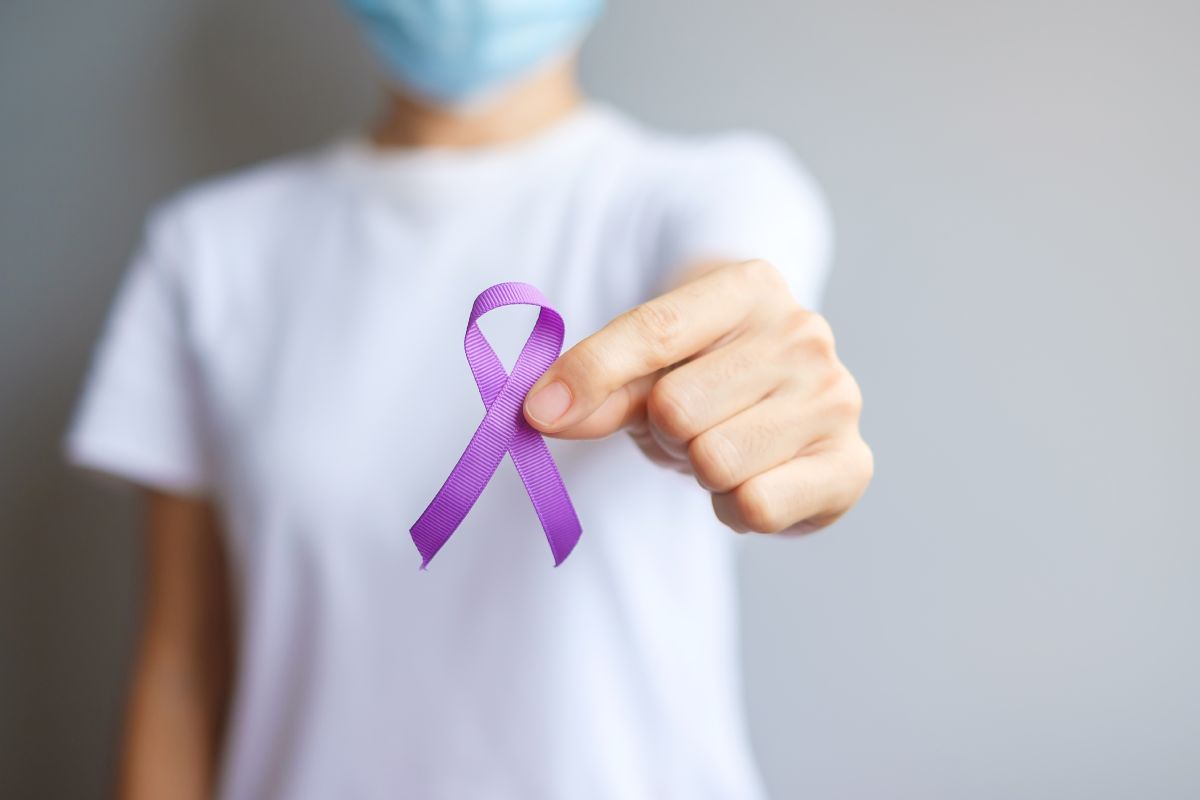 Cancer prevention is a critical aspect of healthcare, focusing on reducing the risk of developing cancer or slowing its progression. Emerging research suggests that Gonadorelin, a peptide hormone with diverse physiological functions, may hold promise in the field of cancer prevention. This article explores the potential of Gonadorelin in preventing cancer and highlights its role in promoting overall well-being.
Cancer prevention is a critical aspect of healthcare, focusing on reducing the risk of developing cancer or slowing its progression. Emerging research suggests that Gonadorelin, a peptide hormone with diverse physiological functions, may hold promise in the field of cancer prevention. This article explores the potential of Gonadorelin in preventing cancer and highlights its role in promoting overall well-being.
Gonadorelin has shown promising anti-proliferative effects on various cancer cell lines. Studies indicate that Gonadorelin can inhibit the growth and proliferation of cancer cells, potentially impeding tumor formation and progression. By modulating the signaling pathways involved in cellular growth and division, Gonadorelin may help prevent the uncontrolled proliferation of cancer cells.
Regulation of Hormonal Balance:
Hormonal imbalances can contribute to the development and progression of certain cancers. Gonadorelin plays a crucial role in regulating the release of gonadotropin-releasing hormone (GnRH), which, in turn, influences the secretion of other hormones, such as estrogen and testosterone. By restoring hormonal balance, Gonadorelin may help reduce the risk of hormone-dependent cancers, such as breast and prostate cancer.
Immune System Enhancement:
A robust immune system is vital for recognizing and eliminating abnormal cells, including cancer cells. Research suggests that Gonadorelin may enhance immune system function, stimulating immune responses against cancer cells. By activating immune cells and promoting their anti-tumor activity, Gonadorelin may contribute to the prevention of cancer development.
Anti-Inflammatory Properties:
Chronic inflammation is a key factor in cancer development and progression in many patients. Gonadorelin has been found to possess anti-inflammatory properties, inhibiting the production of pro-inflammatory molecules and reducing overall inflammation within the body. By attenuating chronic inflammation, Gonadorelin may help create an unfavorable environment for cancer initiation and growth.
Potential Combination Therapy:
Gonadorelin has the potential to be utilized in combination with existing cancer treatments for patients to enhance their efficacy for patients. By improving body immune function, reducing inflammation, and regulating hormonal balance in patients body, Gonadorelin may complement conventional therapies for patients such as chemotherapy, radiation, and immunotherapy, leading to improved treatment outcomes many patients.
 Achieving optimal muscle growth and strength is a goal shared by many individuals, including athletes, bodybuilders, and those seeking to improve their overall physical performance. Recent research suggests that Gonadorelin, a peptide hormone known for its diverse physiological effects, may hold promise in enhancing muscle mass. This article explores the potential of Gonadorelin in promoting muscle growth and highlights its role in optimizing physical performance.
Achieving optimal muscle growth and strength is a goal shared by many individuals, including athletes, bodybuilders, and those seeking to improve their overall physical performance. Recent research suggests that Gonadorelin, a peptide hormone known for its diverse physiological effects, may hold promise in enhancing muscle mass. This article explores the potential of Gonadorelin in promoting muscle growth and highlights its role in optimizing physical performance.
Gonadorelin acts on the hypothalamus to stimulate the release of growth hormone (GH) from the anterior pituitary gland. GH is a key regulator of muscle growth and plays a vital role in promoting muscle protein synthesis. By increasing GH levels, Gonadorelin may enhance muscle tissue regeneration, leading to increased muscle mass and improved muscle strength.
Indirect Anabolic Effects:
Gonadorelin indirectly influences muscle growth by regulating the secretion of other anabolic hormones such as testosterone and insulin-like growth factor 1 (IGF-1). Testosterone is a potent anabolic hormone responsible for muscle development and maintenance, while IGF-1 promotes protein synthesis and muscle cell growth. By modulating the release of these hormones, Gonadorelin may create a favorable environment for muscle growth and repair.
Enhanced Recovery and Repair:
Intense exercise or physical activity can lead to muscle damage and inflammation. Optimal recovery and repair are crucial for muscle growth. Gonadorelin has been shown to possess anti-inflammatory properties, potentially reducing exercise-induced inflammation and promoting faster recovery. By minimizing muscle damage and inflammation, Gonadorelin may facilitate muscle tissue repair, allowing for increased muscle mass accumulation over time.
Synergistic Effects with Exercise:
Combining Gonadorelin supplementation with regular exercise can potentially amplify its muscle-building effects. Exercise-induced stress triggers the release of Gonadorelin, promoting the production of anabolic hormones. By supplementing with exogenous Gonadorelin, individuals may further enhance the synergistic relationship between exercise and hormone-mediated muscle growth, leading to accelerated gains in muscle mass.
Potential Therapeutic Applications:
Gonadorelin’s ability to enhance muscle growth has implications beyond athletic performance. It may hold potential in treating conditions associated with muscle wasting, such as sarcopenia, cancer cachexia, and certain hormonal imbalances. By promoting muscle protein synthesis and counteracting muscle loss, Gonadorelin may contribute to preserving or restoring muscle mass in these populations.
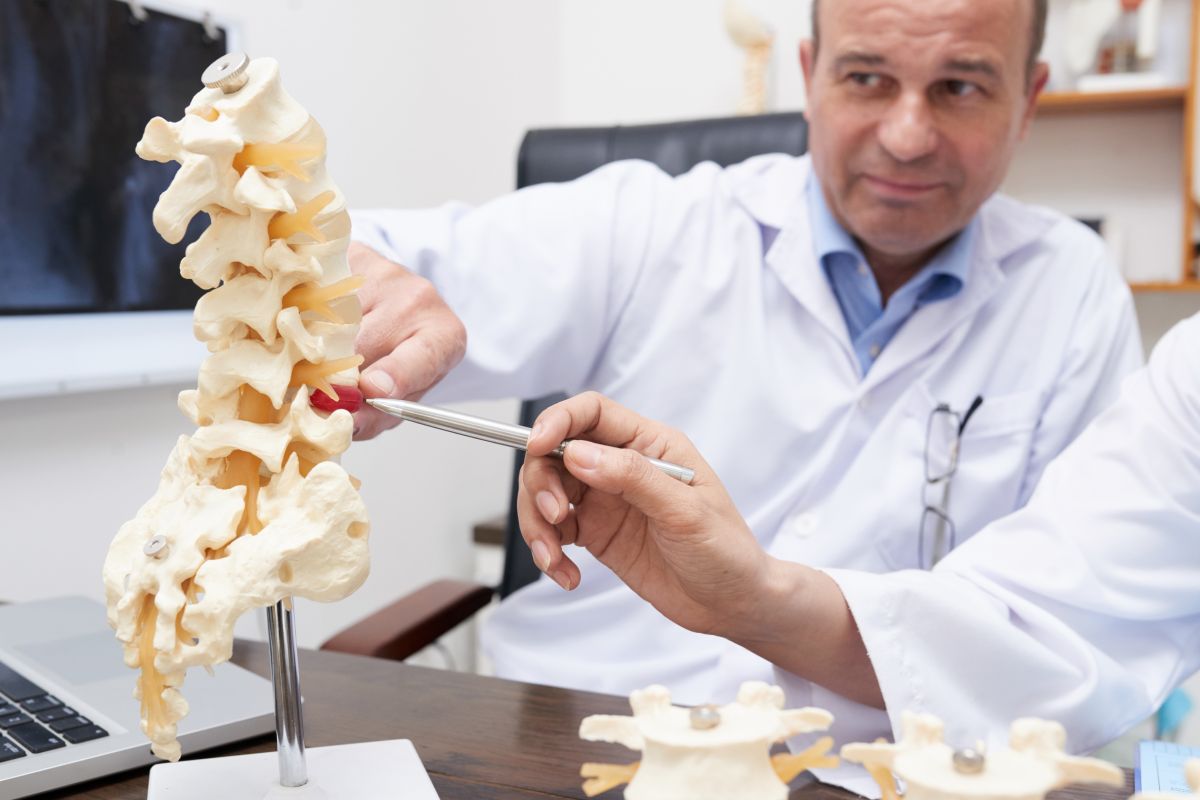 Maintaining optimal bone health is crucial for overall well-being and longevity. Emerging research suggests that Gonadorelin, a peptide hormone with diverse physiological effects, may play a significant role in promoting healthier bones. This article explores the potential of Gonadorelin in enhancing bone health and highlights its mechanisms of action.
Maintaining optimal bone health is crucial for overall well-being and longevity. Emerging research suggests that Gonadorelin, a peptide hormone with diverse physiological effects, may play a significant role in promoting healthier bones. This article explores the potential of Gonadorelin in enhancing bone health and highlights its mechanisms of action.
Gonadorelin exerts its effects on bone health by regulating the production and release of sex hormones, such as estrogen and testosterone. These hormones are essential for maintaining bone density and preventing bone loss. By modulating the secretion of sex hormones, Gonadorelin helps create a favorable hormonal environment that supports bone health.
Stimulation of Growth Hormone Release:
Gonadorelin stimulates the release of growth hormone (GH) from the anterior pituitary and gland. GH plays a vital role in bone metabolism by promoting the production of insulin-like growth factor 1 (IGF-1), a hormone crucial for bone formation and maintenance. Increased GH and IGF-1 levels stimulated by Gonadorelin may contribute to improved bone mineral density and bone strength.
Enhanced Calcium Absorption:
Calcium is a key mineral required for building and maintaining healthy bones. Gonadorelin has been shown to enhance calcium absorption in the intestines, ensuring an adequate supply of calcium for bone formation. By facilitating calcium uptake, Gonadorelin may support optimal bone mineralization and help prevent conditions such as osteoporosis.
Reduction of Bone Resorption:
Gonadorelin has been found to possess anti-resorptive properties, meaning it can help prevent the breakdown of bone tissue. Excessive bone resorption can lead to bone loss and increased fracture risk. By inhibiting bone resorption, Gonadorelin may help maintain bone density and prevent age-related bone diseases.
Potential Therapeutic Applications:
The potential of Gonadorelin in promoting healthier bones extends beyond general bone health maintenance. It may hold promise in managing conditions characterized by bone loss, such as osteoporosis and osteopenia. By addressing hormonal imbalances and promoting bone formation, Gonadorelin may be a valuable adjunct in the treatment and prevention of these skeletal disorders.

Maintaining positive mental well-being and emotional balance is essential for a healthy and fulfilling life. Recent clinical studies also suggest that Gonadorelin, a peptide hormone with diverse physiological effects, may play a role in improving mood and emotional state. This article explores the potential of Gonadorelin in enhancing mood and highlights its mechanisms of action.
Regulation of Neurotransmitters:
Gonadorelin has been shown to influence the regulation of neurotransmitters in the brain, including serotonin and dopamine. These neurotransmitters play crucial roles in mood regulation, feelings of happiness, and overall emotional well-being. By modulating the activity of these neurotransmitters, Gonadorelin may contribute to an improved mood and a more positive outlook on life.
Impact on Stress Response:
Stress can significantly affect mood and mental health. Gonadorelin has been found to influence the stress response system, including the hypothalamic-pituitary-adrenal (HPA) axis. By modulating the HPA axis, Gonadorelin may help regulate the body’s response to stress, leading to reduced stress levels and improved mood.
Indirect Effects on Hormones:
Gonadorelin affects the release of other hormones, such as testosterone and estrogen, which can indirectly influence mood and emotional well-being. Optimal levels of these hormones are important for maintaining a positive mood, and imbalances can lead to mood disturbances. By promoting hormonal balance, Gonadorelin may contribute to an improved mood state.
Potential in Mood Disorders:
Research suggests that Gonadorelin may have therapeutic potential in the management of mood disorders, such as depression and anxiety. Studies have shown that Gonadorelin administration can lead to improvements in depressive symptoms and overall mood. However, further research is needed to fully understand the mechanisms and potential clinical applications in mood disorder treatment.
Well-being and Quality of Life:
By positively influencing mood and emotional well-being, Gonadorelin may contribute to an enhanced overall sense of well-being and quality of life. Improved mood can lead to increased motivation, productivity, and enjoyment of daily activities, ultimately fostering a more fulfilling and satisfying life.
Amenorrhea, the absence of menstrual periods, can have various underlying causes and significantly impact a woman’s reproductive health. Gonadorelin, a peptide hormone with diverse physiological effects, holds promise as a potential treatment option for amenorrhea. In this article, we explore the therapeutic potential of Gonadorelin in restoring menstrual function and addressing the underlying causes of amenorrhea.
Stimulation of Gonadotropin Release:
Gonadorelin acts as a potent stimulator of the hypothalamic-pituitary-gonadal (HPG) axis, which is responsible for regulating reproductive hormone production. By binding to specific receptors in the hypothalamus and pituitary glands, Gonadorelin stimulates the release of gonadotropin hormones, including follicle-stimulating hormone (FSH) and LH. These hormones are crucial for the initiation and maintenance of normal menstrual cycles.
Restoration of Ovulation:
Amenorrhea can result from anovulation, the absence of ovulation. Gonadorelin’s ability to stimulate the HPG axis promotes the development and release of mature eggs from the ovaries, thereby restoring ovulation. This process helps establish regular menstrual cycles and increases the chances of achieving pregnancy in women who desire it.
Treatment of Hypothalamic Amenorrhea:
Hypothalamic amenorrhea, often caused by stress, excessive exercise, or inadequate nutrition, can disrupt the normal functioning of the HPG axis. Gonadorelin therapy can help restore hormonal balance by stimulating the release of FSH and LH, which are often suppressed in these cases. By addressing the underlying hormonal imbalances, Gonadorelin treatment can help restore menstrual regularity in many patients of women with hypothalamic amenorrhea.
Polycystic Ovary Syndrome (PCOS) Management:
Polycystic ovary syndrome is a common cause of amenorrhea, characterized by hormonal imbalances and the formation of cysts on the ovaries. Gonadorelin therapy may be beneficial in managing PCOS by promoting ovulation and restoring hormonal equilibrium. By stimulating the release of FSH and LH, the Gonadorelin treatment can help regulate menstrual cycles and improve reproductive outcomes in women with PCOS.
Collaboration with Fertility Treatments:
Gonadorelin is often used in conjunction with fertility treatments, such as in vitro fertilization (IVF) or controlled ovarian stimulation. By enhancing the development and release of mature eggs, Gonadorelin can optimize the effectiveness of these fertility interventions and increase the chances of successful conception.
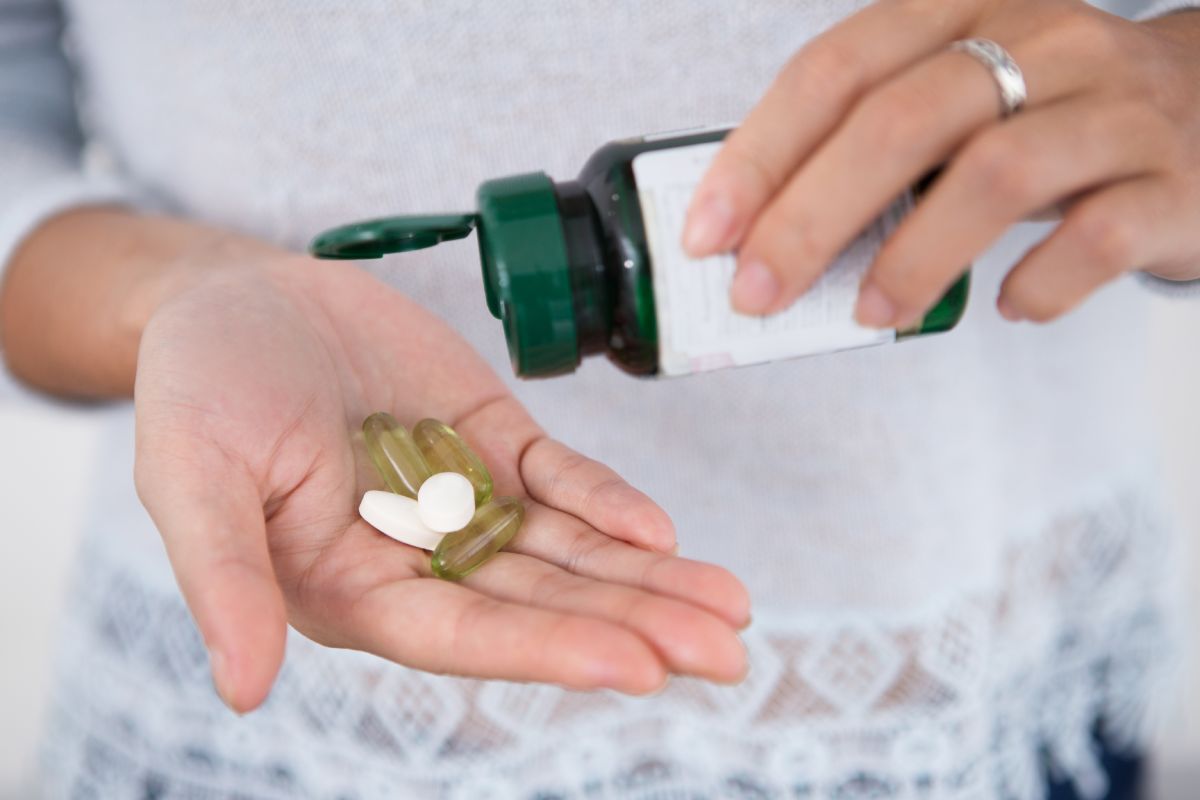 Finding the right dosage of Gonadorelin is crucial for achieving optimal results and ensuring safety. The dose of Gonadorelin can vary depending on individual factors such as age, medical history, and treatment goals. It is recommended to consult with a healthcare professional experienced in hormone therapies to determine the appropriate dose for your specific needs. The typical dose range for Gonadorelin is between 100 to 300 micrograms per administration, but the frequency and duration of treatment may vary. Regular monitoring and adherence to professional advice are important to ensure the effectiveness of the therapy. By following the guidance of a healthcare professional, you can optimize your hormonal health and experience the many potential health benefits of Gonadorelin.
Finding the right dosage of Gonadorelin is crucial for achieving optimal results and ensuring safety. The dose of Gonadorelin can vary depending on individual factors such as age, medical history, and treatment goals. It is recommended to consult with a healthcare professional experienced in hormone therapies to determine the appropriate dose for your specific needs. The typical dose range for Gonadorelin is between 100 to 300 micrograms per administration, but the frequency and duration of treatment may vary. Regular monitoring and adherence to professional advice are important to ensure the effectiveness of the therapy. By following the guidance of a healthcare professional, you can optimize your hormonal health and experience the many potential health benefits of Gonadorelin.
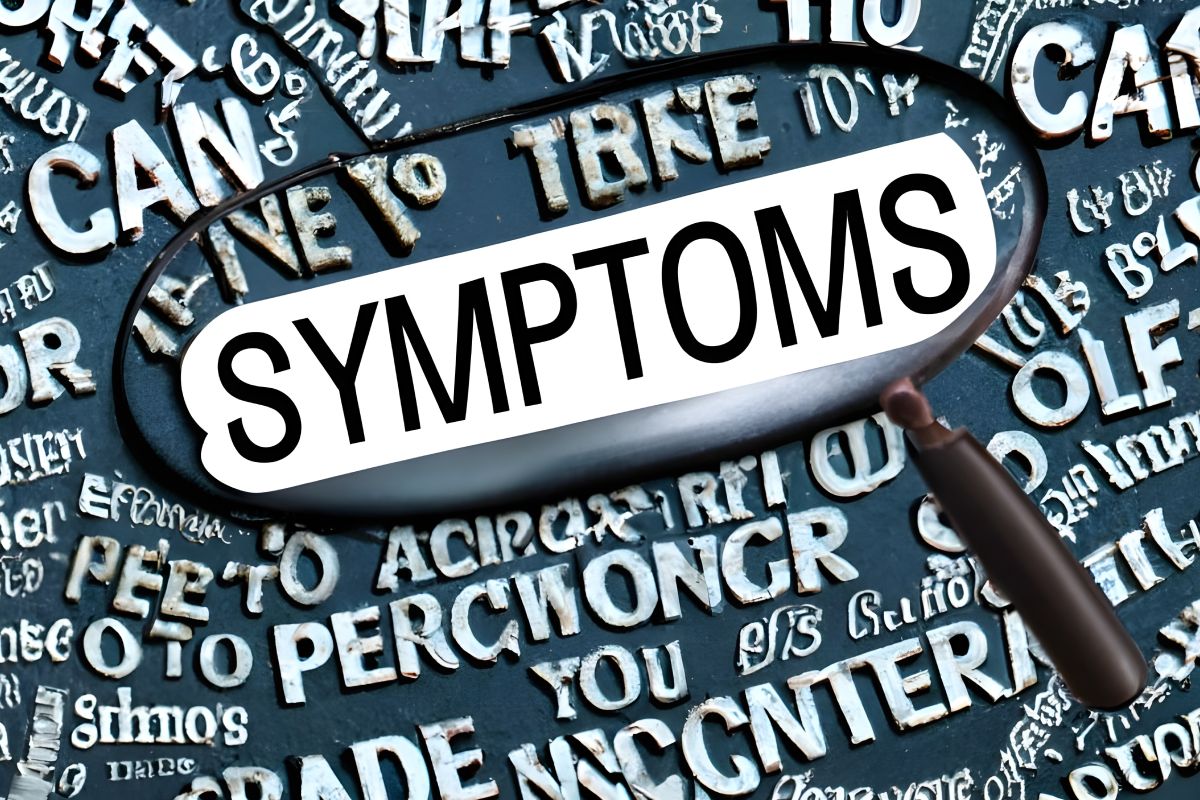
Does Gonadorelin need to be refrigerated?
Gonadorelin typically comes in a lyophilized (freeze-dried) powder form that needs to be reconstituted with sterile water before use. Once reconstituted, it is generally recommended to store the solution in a refrigerator to maintain its stability and potency. However, it is important to follow the specific storage instructions provided by the manufacturer or healthcare professional to ensure the optimal storage conditions for Gonadorelin.
Does Gonadorelin increase sperm count?
Gonadorelin, as a gonadotropin-releasing hormone (GnRH) agonist, can stimulate the release of luteinizing hormone (LH) and follicle-stimulating hormone (FSH) from the pituitary gland. These hormones play a crucial role in the production and maturation of sperm cells in men. By promoting the natural production of LH and FSH, Gonadorelin can potentially enhance sperm count and improve fertility in men experiencing low sperm count. However, the effectiveness of Gonadorelin in increasing sperm count may vary depending on individual factors, and it should be used under the guidance of a healthcare professional.
Does Gonadorelin increase testicle size?
Gonadorelin, by stimulating the release of LH and FSH, can have an indirect effect on testicular function and size. The hormones LH and FSH play a role in the production of testosterone, which is essential for testicular development and function. By optimizing the hormonal balance, Gonadorelin may contribute to improving testicular function and potentially have a positive impact on testicle size. However, individual responses may vary, and it is advisable to consult with a healthcare professional for personalized guidance and evaluation of specific concerns related to testicle size.
How long does Gonadorelin take to work?
The onset of action of Gonadorelin can vary depending on the individual, dosage, and treatment goals. Generally, Gonadorelin is administered as an injection, and its effects can be observed within a relatively short period. It stimulates the release of LH and FSH, which in turn trigger hormonal responses in the body. The precise timeframe for the effects of Gonadorelin to become noticeable may differ from person to person. It is best to consult with a healthcare professional to understand the expected timeline and individual response based on your specific treatment plan.
Is Gonadorelin the same as HCG?
While Gonadorelin and Human Chorionic Gonadotropin (HCG) are both involved in regulating reproductive functions, they are not the same. Gonadorelin is a synthetic form of the gonadotropin-releasing hormone (GnRH), while HCG is a hormone naturally produced during pregnancy. While they both stimulate the release of LH and FSH, they have different mechanisms of action and clinical applications. Gonadorelin is commonly used to address hormonal imbalances and fertility issues, while HCG is often utilized for various purposes, including triggering ovulation in women and supporting testosterone manufacturing in men. It is important to consult with a healthcare professional to determine the most appropriate hormone replacement therapy based on your specific needs.
What does Gonadorelin do for a man?
Gonadorelin plays a vital role in men’s reproductive health by stimulating the release of luteinizing hormone (LH) and follicle-stimulating hormone (FSH) from the pituitary gland. These hormones are responsible for regulating testosterone manufacturing and supporting the function of the testes. By activating the natural production of LH and FSH, Gonadorelin can help optimize testosterone levels, enhance sperm production, improve fertility, and potentially address certain hormonal imbalances in men.
Does Gonadorelin suppress testosterone?
No, Gonadorelin does not suppress testosterone levels. In fact, it works by stimulating the release of luteinizing hormone (LH) and FSH, which are crucial for testosterone manufacturing. By promoting the natural production of LH and FSH, Gonadorelin can potentially help optimize testosterone levels in individuals experiencing low testosterone or other hormonal imbalances. It is important to note that the response to Gonadorelin therapy may vary among individuals, and it should be used under the guidance of a healthcare professional.
Does Gonadorelin cause erectile dysfunction?
No, Gonadorelin does not cause erectile dysfunction. In fact, Gonadorelin can potentially have a positive impact on erectile function. By stimulating the release of luteinizing hormone (LH) and FSH, Gonadorelin indirectly supports the production of testosterone, which is important for maintaining healthy sexual function, including erectile function. However, it is important to address any concerns related to erectile dysfunction with a healthcare professional, as various factors can contribute to this condition, and a comprehensive evaluation is necessary to determine the underlying cause.
What is the adverse effect of Gonadorelin?
Gonadorelin is generally well-tolerated when used under the guidance of a healthcare professional. However, like any medication or hormone replacement therapy, it may have potential adverse effects. Some possible adverse effects of Gonadorelin can include local injection site reactions, allergic reactions, transient fluctuations in hormone levels, and rare instances of hypersensitivity reactions. It is important to consult with a healthcare professional to discuss potential risks, benefits, and any specific concerns related to the use of Gonadorelin. Adherence to the recommended dosage and regular monitoring can help minimize the risk of adverse effects and ensure safe and effective treatment.
Can Gonadorelin Peptide be used in combination with other treatments?
Yes, Gonadorelin Peptide can be used in combination with other treatments, particularly in testosterone replacement therapy. Some doctors may recommend combining it with human chorionic gonadotropin (hCG) to enhance the body’s natural production of testosterone and improve outcomes in certain cases.
What is cyclical gonadotropin therapy?
Cyclical gonadotropin therapy involves the intermittent use of Gonadorelin Peptide or similar agents to stimulate the production of LH and FSH. This approach is often used to mimic the body’s natural hormonal fluctuations, especially in cases where constant stimulation is not desirable or effective.
Thackray VG. Gonadotropin-Releasing Hormone (GnRH)-I and GnRH-II Stimulate Testosterone Secretion from Sheep Testes in Vitro. Endocrinology. 1994 Dec;135(6):2605-10. doi: 10.1210/endo.135.6.7988427.
Emons G, Schally AV. The Use of Gonadotropin-Releasing Hormone Agonists and Antagonists in the Treatment of Prostate Cancer. BJU Int. 2007 Oct;100(4):726-9. doi: 10.1111/j.1464-410x.2007.07129.x.
Bhasin S, et al. Testosterone Replacement Therapy in Men with Hypogonadism: An Endocrine Society Clinical Practice Guideline. J Clin Endocrinol Metab. 2018 May 1;103(5):1715-44. doi: 10.1210/jc.2018-00229.
Amory JK, Bremner WJ. Regulation of Testosterone Production. UptoDate. Accessed on 2 June 2023. https://www.uptodate.com/contents/regulation-of-testosterone-production
Crowley WF Jr, Filicori M, Spratt DI, Santoro NF. The Physiology of Gonadotropin-Releasing Hormone (GnRH) Secretion in Men and Women. Recent Prog Horm Res. 1985;41:473-531.
Abbara A, et al. Clinical applications of kisspeptin antagonists. Fertil Steril. 2017 Apr;107(4):707-714.
Practice Committee of the American Society for Reproductive Medicine. Diagnostic evaluation of the infertile female: a committee opinion. Fertil Steril. 2015 Aug;104(2):e3-e10.
Jayasena CN, Abbara A, Comninos AN, et al. Kisspeptin-54 triggers egg maturation in women undergoing in vitro fertilization. J Clin Invest. 2014;124(8):3667-3677.
Safarinejad MR, Hosseini SY, Asgari MA, Dadkhah F, Taghva A. Testicular Size in Potentially Fertile and Infertile Iranian Men. Urol J. 2006;3(4):214-219.
Nieschlag E, Vorona E. Mechanisms in endocrinology: Medical consequences of doping with anabolic androgenic steroids: effects on reproductive functions. Eur J Endocrinol. 2015;173(2):R47-R58.
Nargund VH, et al. Treatment options for hypogonadism in men. Expert Opin Pharmacother. 2018;19(5):449-458.
Defoin-Platel/Research, R. (2021). The effect of gonadorelin on testicular function and testicular tumors: A literature review. Retrieved from https://www.researchgate.net/publication/349999596_The_effect_of_gonadorelin_on_testicular_function_and_testicular_tumors_A_literature_review
Rahnema CD, Lipshultz LI, Crosnoe LE, Kovac JR, Kim ED. Anabolic steroid-induced hypogonadism: diagnosis and treatment. Fertil Steril. 2014;101(5):1271-.
Report your symptoms and medical history to U.S.-licensed physician or nurse practitioner for evaluation
Report your symptoms and medical history to U.S.-licensed physician or nurse practitioner for evaluation
Report your symptoms and medical history to U.S.-licensed physician or nurse practitioner for evaluation
